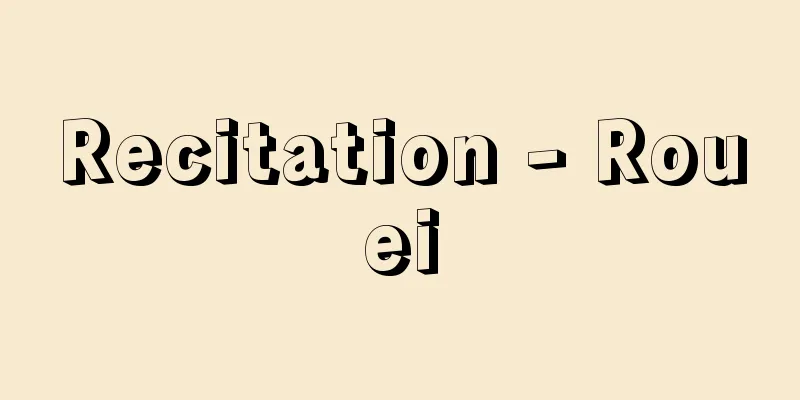Recitation - Rouei

|
The name of a vocal genre of gagaku. Along with saibara, it was created in the Heian period as a type of singing, and is performed with Chinese wind instruments. It is also included in the broader definition of eikyoku. In contrast to metrical saibara, which uses local folk songs as lyrics, roei uses a two-stanza Chinese poem, has free meter, and has no meter. The Chinese poem is divided into one to three lines, and the beginning of each line is sung solo, and from the point where the instruction "attach" is made, it is sung in unison with the accompaniment of a sho, hichiriki, and ryuteki (each with one instrument). The sho is played with a single piece of bamboo, not with a bamboo pole. The Seven Fundamental Poems include "Gokurakuson" and "Toku wa Kore Hokushin," which Minamoto Masanobu is said to have given a certain melody to. Later, the number of pieces increased, and Fujiwara Munetada and Tadazane wrote "Kyujushu Roei Sho," and Fujiwara Kinto wrote "Wakan Roei Shu." From the Heian period to the beginning of the Kamakura period, Kagurauta, Saibaraku, and eventually Imayo were also included, and these were widely loved by the court nobles as elegant songs. There were two schools of poetry, the Genke and the Touke, but the Touke became extinct, and during the Meiji period, the following pieces were selected to be performed at the Imperial Household Agency: "Kashin," "Togan," "Tokuha Kore," "Jisei," "Ikesuzushi," "Akatsuki Ryoou," "Koyo," "Harusugi," "Shinpo," "Shokon," "Kyuuka," "Issei," "Taizan," and "Hanajoen." [Yoko Hashimoto] Source: Shogakukan Encyclopedia Nipponica About Encyclopedia Nipponica Information | Legend |
|
雅楽の声楽種目名。謡物(うたいもの)として催馬楽(さいばら)と並んで平安時代につくられ、唐楽管絃(かんげん)で演奏される。広義の郢曲(えいきょく)にも含まれる。地方の民謡を詞章とした拍節的な催馬楽に対して、朗詠は二節一連の漢詩を用い、自由拍子で拍節はない。漢詩を一ノ句から三ノ句に分け、各句の初めを独唱、「付所(つけどころ)」の指示がある箇所からは笙(しょう)・篳篥(ひちりき)・竜笛(りゅうてき)(各一管)の付奏により斉唱で謡われる。笙は合竹(あいたけ)ではなく一本吹。 源雅信が一定の曲節をつけたという『極楽尊』『徳是北辰(とくはこれほくしん)』などを根本七首と称す。のちに曲目が増え、藤原宗忠・忠実(ただざね)らは『朗詠九十首抄』、藤原公任(きんとう)は『和漢朗詠集』を著した。平安から鎌倉初めにかけては、神楽歌(かぐらうた)・催馬楽、やがては今様(いまよう)も含めて広く郢曲として宮廷貴族に親しまれる。歌法には源家(げんけ)と藤家(とうけ)があったが藤家は絶え、明治時代に宮内庁で演奏すべきものとして『嘉辰(かしん)』『東岸(とうがん)』『徳是(とくはこれ)』『二星(じせい)』『池冷(いけすずし)』『暁梁王(あかつきりょうおう)』『紅葉(こうよう)』『春過(はるすぎ)』『新豊(しんぽう)』『松根(しょうこん)』『九夏(きゅうか)』『一声(いっせい)』『泰山(たいざん)』『花上苑(はなじょうえん)』が撰定(せんてい)された。 [橋本曜子] 出典 小学館 日本大百科全書(ニッポニカ)日本大百科全書(ニッポニカ)について 情報 | 凡例 |
Recommend
Graptolite (English spelling)
A marine fossil animal belonging to the Hemichord...
Acorns - Acorns
The fruit of beech family plants such as sawtooth ...
Survival of Pagan Gods
…Such images of unexpected encounters between the...
Miyakubo [town] - Miyakubo
A former town in Ochi County in northern Ehime Pre...
Sitka (English spelling)
A city on the west coast of Baranov Island in the...
Orchestral music
(1) The name of a style of gagaku music. Formerly ...
Azuma Mogura (English name) Japanese mole
An animal of the mammalian class, insectivora, fa...
Avant-garde theatre - Zen'ei-geki
A play that breaks away from established theatrica...
Transportation - Unpan
It means to move the location of materials, human...
vertebral column
…the olecranon, capitellum, and styloid process a...
Japan Atomic Energy Research Institute
Abbreviated as "JAEA". A special corpora...
Kihoku Basin
...Population 11,625 (1995). Surrounded by mounta...
Akanko - Akanko
…It is also known as the Regimental Flag Jellyfis...
Emilia sagittata (English spelling) Emilia sagittata
…[Hiroji Koyama]. . … *Some of the terminology th...
Hylas
…For the most part, they are friendly to humans, ...






![Rudolf [I] - Rudolf](/upload/images/67cd30f647d2e.webp)


